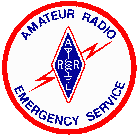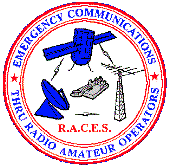

 ARES is a public
service organization of the American Radio Relay League, consisting of licensed
amateurs who have voluntarily registered their qualifications and equipment to
supply communications when disaster strikes or for public events, in the
interest of informing amateurs and the general public concerning the operations
and programs designed as a public service in times of emergencies and special
events. ARES groups in all United States are dedicated to serving the
communities in which we live, working hand in hand with the American Red Cross,
local and state governments, and other nonprofit, community-service
organizations. ARES provides emergency communications when all normal means of
communications have failed due to storm damage or being jammed by overuse. .
ARES is a public
service organization of the American Radio Relay League, consisting of licensed
amateurs who have voluntarily registered their qualifications and equipment to
supply communications when disaster strikes or for public events, in the
interest of informing amateurs and the general public concerning the operations
and programs designed as a public service in times of emergencies and special
events. ARES groups in all United States are dedicated to serving the
communities in which we live, working hand in hand with the American Red Cross,
local and state governments, and other nonprofit, community-service
organizations. ARES provides emergency communications when all normal means of
communications have failed due to storm damage or being jammed by overuse. .
![]()

Founded in 1952, the Radio Amateur Civil Emergency Service (RACES) is a public service that provides a reserve communications group within government agencies in times of extraordinary need. During periods of activation, RACES personnel are called upon to perform many tasks for the government agencies they serve. Although the exact nature of each activation will be different, the common thread is communications.
The Federal Communications Commission (FCC) is responsible for the regulation of RACES operations. Each RACES group is administrated by a local, county, or state civil defense agency responsible for disaster services. This civil defense agency is typically an emergency services or emergency management organization, sometimes within another agency such as police or fire. In some areas, RACES may be part of an agency's Auxiliary Communications Service (ACS). Some RACES groups call themselves by other names (often to avoid confusion with similarly sounding terms such as “racist” or “horse races”), such as ACS, DCS (Disaster Communications Service), or ECS (Emergency Communications Service)..
The importance of RACES operations cannot be stressed enough. The Amateur Radio Regulations, Part 97, Subpart F, were created by the FCC to describe RACES operations in detail. Although no longer issued (but still valid and renewable), special licenses were issued in the past by the FCC to government agencies for RACES operations.
RACES provides a pool of emergency communications personnel that can be called on in time of need. RACES groups across the country prepare themselves for the inevitable day when they will be called upon. When a local, county, or state government agency activates its RACES group, that group will use its resources to meet whatever need that agency has.
Traditional RACES operations involve emergency message handling on Amateur Radio Service frequencies. These operations typically involve messages between critical locations such as hospitals, emergency services, emergency shelters, and any other locations where communication is needed. These communications are handled in any mode available, with 2 meters FM being the most prevalent.
Other tasks that RACES personnel are involved with may not involve amateur-radio communications. For example, RACES communicators may become involved in public-safety or other government communications, Emergency Operations Center (EOC) staffing, and emergency equipment repair.
Whatever need arises, trained RACES personnel are ready and prepared to help. RACES groups develop and maintain their communications ability by training throughout the year with special exercises and public-service events. When that fateful day occurs, RACES will be there to meet the challenge.
![]()

Despite the elaborate radar and forecasting equipment at the National Weather Service, they are only able to determine the potential for severe weather. They rely on reports from the public and law enforcement personnel and actual severe weather.
Accurate and reliable information from the general public is difficult to obtain. Severe weather is complicated and confusing. The NWS has found that only regular training of weather spotters improves the quality of information. The National Weather Service (NWS) collaborates with Amateur Radio organizations and others to put together training programs. The NWS brings its weather knowledge, the Amateur Radio Service brings its expertise in emergency communications, and together they work with local government and the Red Cross.
The Amateur Radio's operators participation in the Skywarn program is formally acknowledged and encouraged in a Memorandum of Understanding (MOU) between the Amateur Radio Relay League (ARRL) and the NWS. This agreement indicaties thet ARRL will encourage its local volunteer groups operating as the Amateur Radio Emergency Services (ARES) to provide the NWS with spotters and communicators as requested by the NWS during times of severe weather.
Trained Skywarn observers provide the Weather Service with accurate, and timely reports from radio equipped cars and homes. The NWS is most interested in severe weather reports. Severe weather includes flash flooding, hail, damaging winds, a wall cloud (which is the area of a thunderstorm where a tornado could form) and a tornado funnel. If the NWS confirms severe weather with radar and other available information, it then notifies local authorities who then can activate Civil Defense sirens. The news media recieves notification so they can make reports on local broadcast stations.
Skywarn volunteers donate thousands of hours and the use of their own personal radio equipment and vehicles to give their communities advanced warning of life threatening weather. Since the NWS instituted the Skywarn Program, there has been a significant decrease in the death rate due to tornadoes and other severe weather.